Vegan Pad Thai: A Deliciously Authentic and Plant-Based Delight! 🍜🌱🌶️
1. Introduction
Craving the vibrant flavors of Thailand but following a vegan lifestyle? Look no further! This recipe for Vegan Pad Thai brings the authentic taste of this classic dish to your kitchen, completely free of animal products. Whether you’re a seasoned vegan or simply exploring plant-based options, this Vegan Pad Thai is a guaranteed crowd-pleaser. This dish is not only delicious but also packed with nutrients from fresh vegetables and plant-based protein, making it a fulfilling and wholesome meal. If you are into vegan recipes, make sure to check our other vegan recipes.
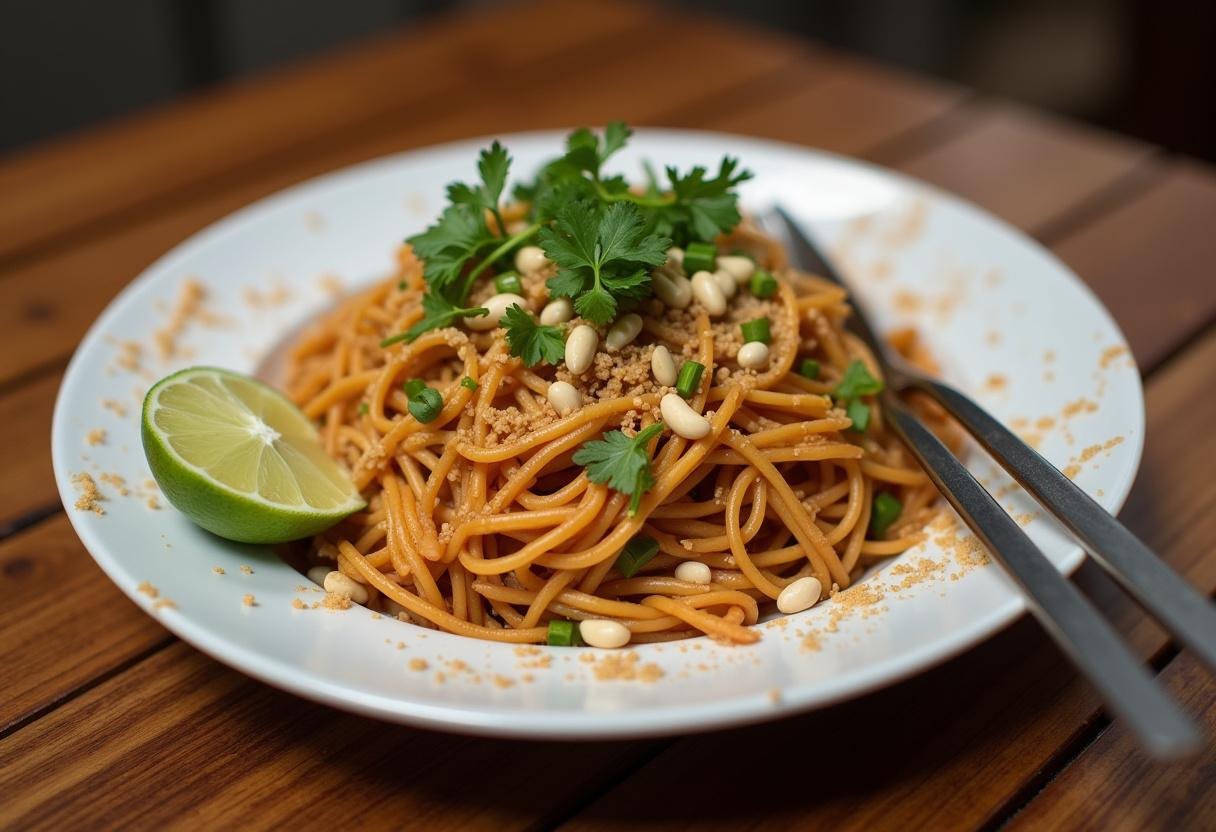
In this article, we’ll guide you through each step of creating a mouthwatering Vegan Pad Thai at home. We’ll cover essential ingredient substitutions, detailed cooking techniques, and provide crucial tips for achieving the perfect balance of sweet, sour, and savory flavors that define authentic Pad Thai. Get ready to impress your friends and family with this flavorful and healthy Vegan Pad Thai! If you like this recipe, perhaps you should browse our other recipes.
2. Understanding Vegan Pad Thai
Traditional Pad Thai typically includes ingredients like fish sauce and shrimp. However, creating a delicious Vegan Pad Thai involves swapping these out for plant-based alternatives that still deliver the same depth of flavor and umami. For instance, instead of fish sauce, we’ll use soy sauce combined with other ingredients to replicate that savory taste. Key to a great Vegan Pad Thai is a well-balanced sauce. This recipe uses a combination of soy sauce, tamarind paste, lime juice, and sugar to mimic the traditional sweet, sour, and savory profile. This balanced sauce is essential for achieving that authentic Pad Thai taste. The beauty of Vegan Pad Thai lies in its versatility – you can easily customize the vegetables and protein sources to your liking. For example, you can add more vegetables for a healthier dish, or adjust the spice level to suit your preference.
3. Key Ingredients for the Best Vegan Pad Thai
- Rice Noodles: These are the foundation of any Pad Thai, providing the perfect texture and base for the flavorful sauce and toppings. Ensure they are gluten-free if needed.
- Tofu: Provides a great source of protein that is essential for a balanced meal. Use firm or extra-firm tofu and press it to remove excess water to ensure it crisps up nicely when stir-fried.
- Vegetables: Bean sprouts, carrots, and green onions are classic choices, adding crunch and freshness to the dish. But feel free to experiment with bell peppers, broccoli, or mushrooms to customize your Vegan Pad Thai.
- Vegan Pad Thai Sauce: This is where the magic happens! A blend of soy sauce, tamarind paste, lime juice, maple syrup (or brown sugar), and chili garlic sauce creates the perfect flavor, balancing sweet, sour, and spicy notes. You can find similar recipes on websites like Nora Cooks for inspiration.
- Peanuts: Adds a satisfying crunch and nutty flavor that complements the other ingredients.
- Lime Wedges: Essential for adding a final burst of acidity that brightens up the dish.
- Optional Toppings: Cilantro, sriracha, and sesame seeds can enhance the dish further, adding visual appeal and extra layers of flavor.
4. Step-by-Step Recipe for Vegan Pad Thai
1. Prepare the Vegetables
Chop your vegetables into bite-sized pieces. This ensures they cook evenly and are easy to eat with the noodles. Set them aside in a bowl, ready to be added to the wok. Preparing the vegetables in advance streamlines the cooking process and ensures a smooth stir-fry. You can even do this step a day ahead to save time.

2. Cook the Rice Noodles
Soak the rice noodles in hot water for about 10-15 minutes, or until they are pliable but not fully cooked. Drain the noodles well. This step is crucial to prevent them from becoming mushy when stir-fried. Undercooking slightly ensures the noodles will absorb the flavorful sauce without becoming overly soft. If you’re looking for side dish ideas, consider roasted sweet potato wedges – they’re delicious!
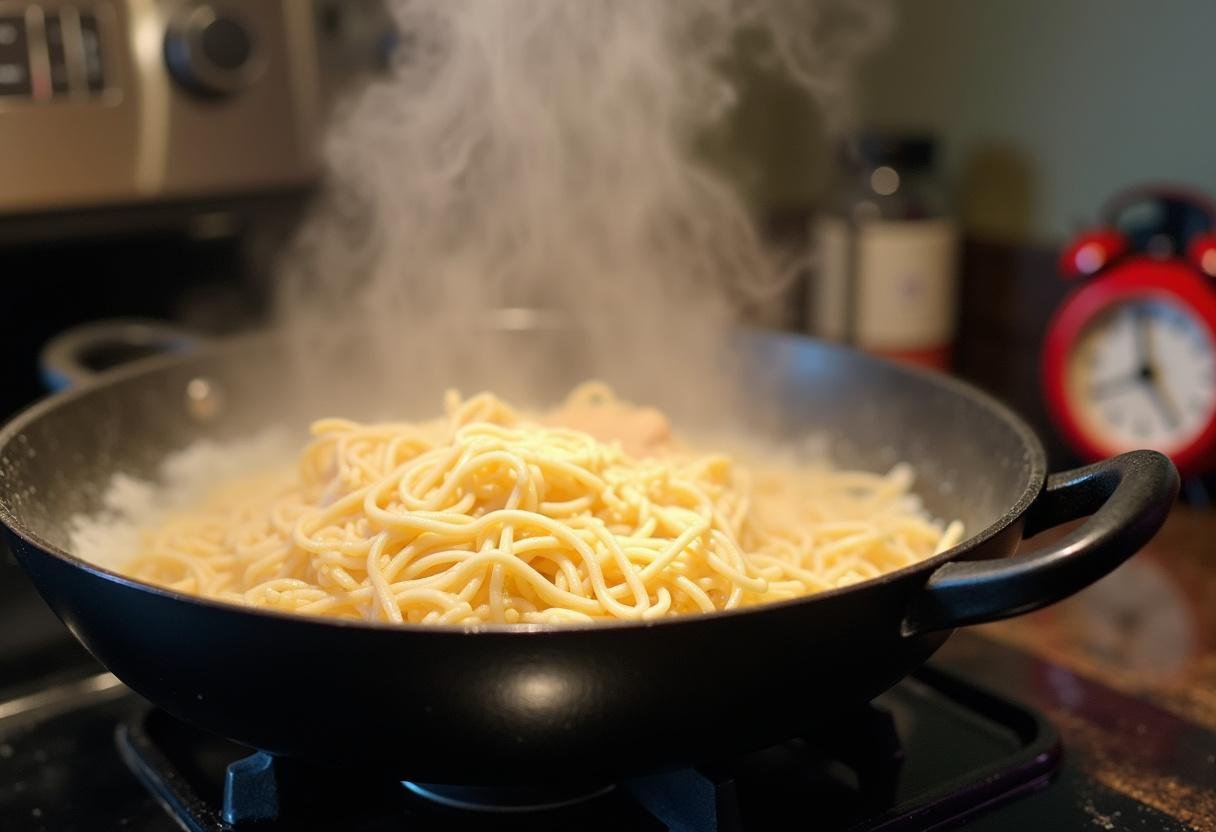
3. Prepare the Tofu
Press the tofu to remove excess water. This is a crucial step to achieve a crispy texture. Cut the tofu into small cubes. In a bowl, season the tofu with a little soy sauce and a pinch of salt and pepper to enhance its flavor. Marinating the tofu, even briefly, adds depth of flavor that elevates the final dish. If you are fond of marinating, you can also tryHerb Lemon Grilled Chicken.

4. Stir-Fry Everything Together
Heat oil in a wok or large skillet over medium-high heat. Add the tofu and stir-fry until golden brown. Add the chopped vegetables and continue stir-frying until they are tender-crisp. Add the noodles and the Vegan Pad Thai sauce. Stir-fry until the noodles are evenly coated and heated through. Garnish with chopped peanuts, lime wedges, and your choice of toppings. The key to a great stir-fry is high heat and constant movement, ensuring all the ingredients cook evenly and develop a lovely char.
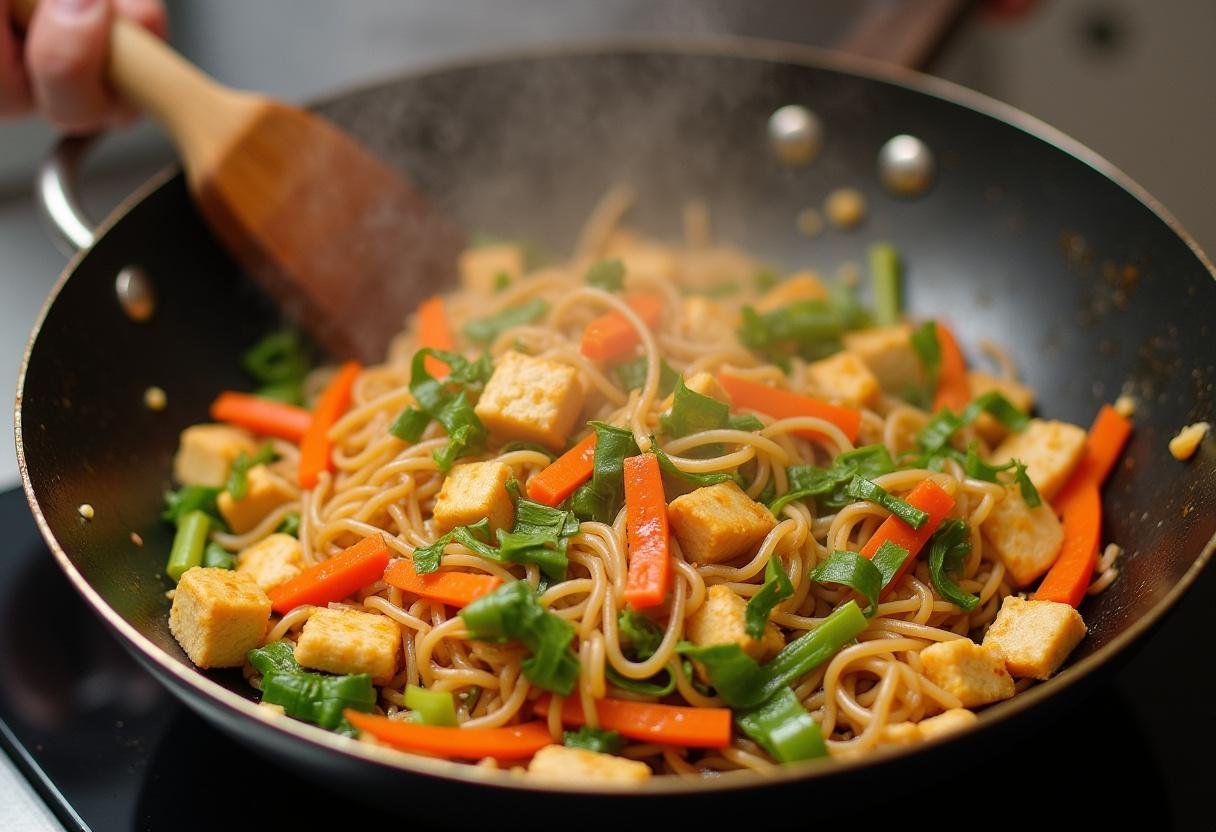
5. Tips for Perfecting Your Vegan Pad Thai
- Don’t Overcook the Noodles: Overcooked noodles will become mushy and lose their appealing texture. Keep a close eye on them while soaking and stir-frying.
- Taste and Adjust the Sauce: Everyone’s taste preferences are different. Adjust the amount of lime juice, sugar, or chili garlic sauce to your liking to create a sauce that perfectly suits your palate.
- Use a Hot Wok: A hot wok is essential for achieving the right texture and flavor, allowing the ingredients to cook quickly and develop a slight char.
- Prepare Ingredients in Advance: Having all your ingredients prepped and ready to go will make the cooking process much smoother and more enjoyable.
6. Variations and Additions to Vegan Pad Thai
The beauty of Vegan Pad Thai is its adaptability. Here are a few variations to try:
- Add Different Vegetables: Experiment with snap peas, bok choy, or even shredded cabbage for added texture and flavor.
- Try Different Protein Sources: Instead of tofu, use tempeh or seitan for a different protein option and a unique texture.
- Make it Spicy: Add more chili garlic sauce or a pinch of red pepper flakes for an extra kick of heat.
- Add fruit: Some people love to add mango or pineapple for a sweet touch, balancing the savory and spicy flavors. Consider serving this with a side salad with apple cider vinegar dressing.
7. Health Benefits of Vegan Pad Thai
Vegan Pad Thai offers a variety of health benefits. It’s packed with nutrients from the vegetables like carrots and sprouts, providing essential vitamins and minerals. It also provides a good source of plant-based protein from the tofu, which is crucial for muscle building and repair. By using whole, unprocessed ingredients, you can create a healthy and satisfying meal that is both delicious and nutritious. Furthermore, this Vegan Pad Thai is lower in saturated fat and cholesterol compared to traditional versions, making it a heart-healthy choice.
8. Serving and Storing Vegan Pad Thai
Serve your Vegan Pad Thai immediately for the best flavor and texture. Freshly cooked Pad Thai is always the most delicious! Leftovers can be stored in an airtight container in the refrigerator for up to 2-3 days. Reheat gently in a skillet or microwave. Add a splash of water to prevent the noodles from drying out and maintaining their texture. Vegan Pad Thai can perfectly served with Baked Parmesan Asparagus or our Roasted Carrot Soup. If you’re seeking an additional salad option, explore our Grilled Halloumi Salad. And for a lighter side, Roasted Garlic Mashed Cauliflower makes a great addition.
9. Conclusion
Creating a delicious and authentic Vegan Pad Thai at home is easier than you might think! By using simple ingredient substitutions and following our step-by-step recipe, you can enjoy this classic Thai dish without any animal products. With its vibrant flavors, customizable ingredients, and health benefits, Vegan Pad Thai is a fantastic meal option for everyone. So, gather your ingredients, fire up the wok, and get ready to savor the vibrant flavors of Vegan Pad Thai. Enjoy your culinary adventure! And perhaps next time you can try our Herb Crusted Halibut!
“`
Print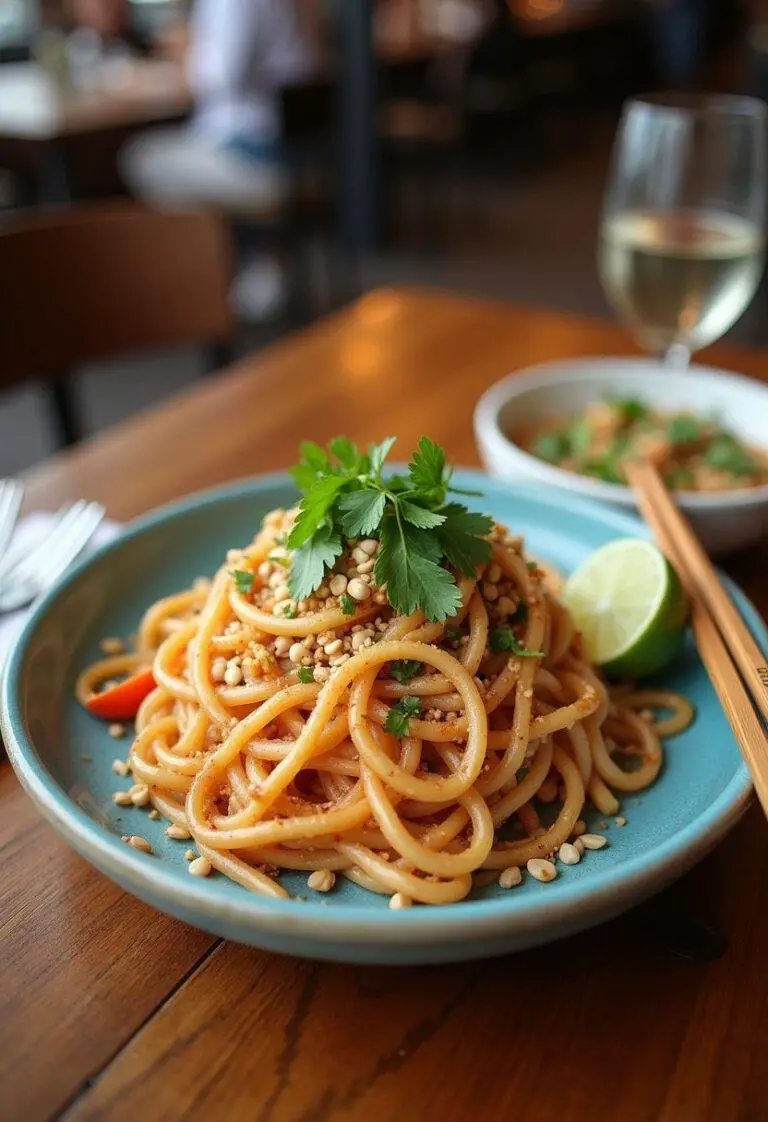
Vegan Pad Thai
Vegan Pad Thai: A Deliciously Authentic and Plant-Based Delight, packed with vibrant flavors and plant-based protein, making it the perfect option for both vegans and non-vegans alike.
- Total Time: 30 minutes
- Yield: 4 servings
Ingredients
- Rice Noodles (ensure gluten-free if needed)
- Tofu (firm or extra-firm, pressed to remove excess water)
- Vegetables (bean sprouts, carrots, green onions, or your choice such as bell peppers, broccoli, or mushrooms)
- Vegan Pad Thai Sauce (blend of soy sauce, tamarind paste, lime juice, maple syrup or brown sugar, and chili garlic sauce)
- Peanuts (for garnish)
- Lime Wedges (for serving)
- Optional Toppings (cilantro, sriracha, sesame seeds)
Instructions
- Chop your vegetables into bite-sized pieces and set aside.
- Soak the rice noodles in hot water for 10-15 minutes until pliable, then drain.
- Press the tofu to remove excess water, cut into cubes, and season with soy sauce, salt, and pepper.
- Heat oil in a wok or large skillet, stir-fry the tofu until golden, add chopped vegetables, and cook until tender-crisp.
- Add the rice noodles and Vegan Pad Thai sauce, stir-fry until the noodles are coated and heated through.
- Garnish with peanuts, lime wedges, and your choice of toppings.
Notes
- Don’t overcook the noodles; they should remain firm.
- Taste and adjust the sauce according to your preference.
- A hot wok is crucial for the right texture.
- Prep all ingredients in advance for a smoother cooking process.
- Prep Time: 15 minutes
- Cook Time: 15 minutes
- Category: Main Course
- Method: Stir-fry
- Cuisine: Thai
- Diet: Vegan
Nutrition
- Serving Size: 1 plate
- Calories: 400 Kcal
- Sugar: 6g
- Sodium: 800mg
- Fat: 18g
- Saturated Fat: 2g
- Unsaturated Fat: 16g
- Trans Fat: 0g
- Carbohydrates: 50g
- Fiber: 4g
- Protein: 15g
- Cholesterol: 0mg

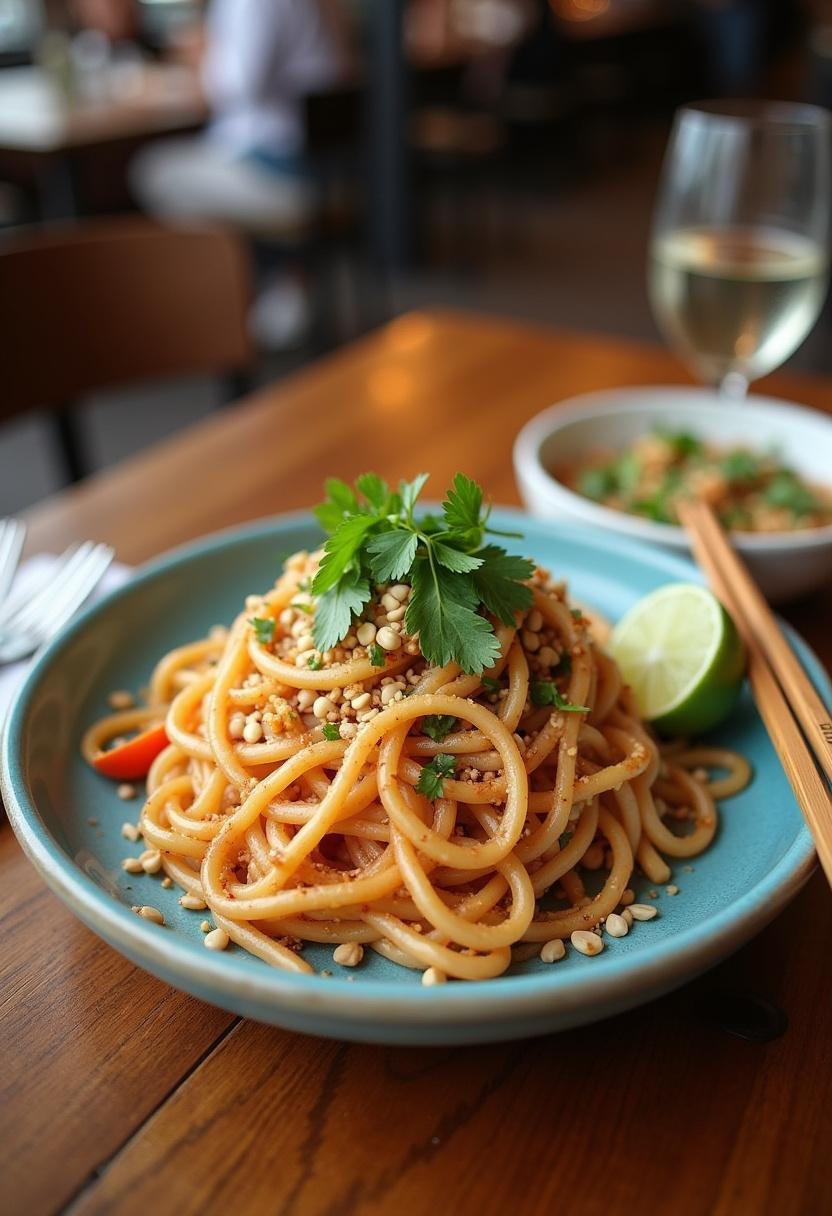
1 thought on “Vegan Pad Thai”